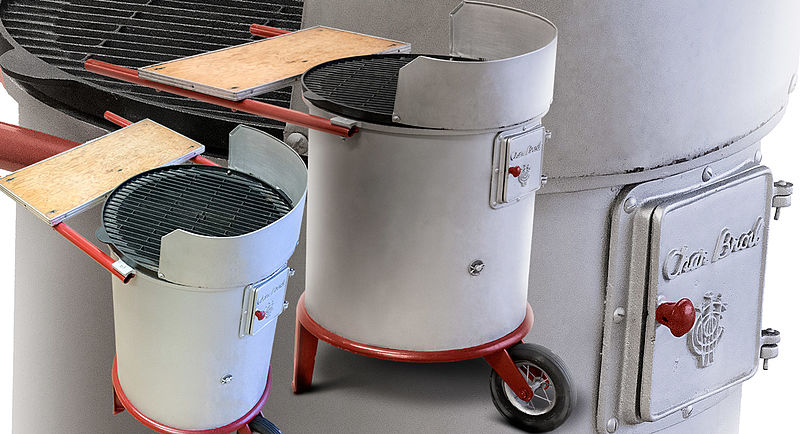
All grills fit into one of two groups, based on their fuel source.
Gas Grills
View this post on Instagram
Most gas grills run on propane gas stored in a tank beneath the grill, though some also run on natural gas supplied by an outlet that connects to your home’s natural gas line. Both types of gas grills consist of the following:
- Body: This is the part that houses the grill.
- Lid: The lid closes or opens over the body, depending on your cooking needs.
- Cooking grate: This holds the food as it cooks.
- Lava rocks or porcelain briquettes: Lava rocks or porcelain briquettes even out the heat produced by the burner so all parts of the grill receive the same amount of heat.
- Rock grate: This fits into the grill body just above the burner and holds the lava rocks or porcelain briquettes.
- Burner: The burner ignites the gas to produce flames.
- Gas valve: This connects to the gas source, supplying the burner with gas.
- Controls: All gas grills have controls that allow you to ignite the burner or control the temperature of the fire by turning a dial or pushing a button. Controls differ from grill to grill.
Charcoal Grills

Charcoal grills are basic, bowl-shaped grills that use charcoal as fuel and must be lit manually. Two grates fit in the bowl: a coal grate near the bottom holds the charcoal, and a cooking grate at the top holds the cooking food. A lid fits over the bowl, and vents at the top of the lid and the bottom of the bowl can be opened or closed to control air flow and fire temperature. Charcoal grills come in three main styles:
- Kettle grill: The most popular form of charcoal grill, a kettle grill has a deep, rounded metal bowl that provides even heat transfer to the entire grilling surface. Kettle grills come in a wide range of sizes, and cost from $30 to $1,000 or more.
- Ceramic cooker: The dense walls and lids of these grills improve heat retention and radiation, allowing the grills to cook foods from all directions (instead of just from below). If you want to barbecue and grill using the same cooker, a ceramic grill is the best option. Ceramic cookers are usually more expensive than comparably sized kettle grills.
- Hibachi: Ideal for travel use, a hibachi is a miniature shallow charcoal grill. Due to their size, hibachis are best for cooking small food items, such as hot dogs, hamburgers, pieces of chicken, and vegetables.
Pick the Right Grill for You
To decide whether to choose a gas or charcoal grill and which specific type of grill you should buy, consider:
- Price
- Convenience
- Flavor
- Flexibility
- Assembly
- Size
Price
Though gas and charcoal grills can vary greatly in price, charcoal grills are generally less expensive than gas grills. Charcoal grills range from $30 for a hibachi or small kettle grill to more than $400 for a high-end kettle grill or ceramic cooker. Low-end gas grills start as low as $150, but top-of-the-line models can cost as much as $6,000.
Convenience
Charcoal grills are considerably more demanding than gas grills because they require building and maintaining a charcoal fire. If you’ll be grilling very often or for many people, the convenience of a gas grill might be worth the expense. If you don’t plan to use your grill a lot, or you’d enjoy building a fire, a charcoal grill may be the better choice.
Flavor
Burning charcoal produces smoky aromas and residue that stick to the surface of grilled foods. Some people find that this gives charcoal-grilled foods a deeper flavor than foods cooked on a gas grill, whereas others can’t tell the difference. Before buying a grill, do some taste tests on friends’ grills to see whether you have a preference.
Flexibility
If you’re interested in using your grill to both barbecue and grill food, you’re better off with a charcoal grill. Though gas grills can be used to barbecue, charcoal grills (particularly ceramic cookers) are better for barbecuing.
Assembly
Charcoal grills are easy to assemble, but some gas grills can be difficult to put together. Make sure to ask about the difficulty of assembly before purchasing a gas grill.
Size
Whether you decide to purchase a gas or charcoal grill, make sure you buy the right size grill for your needs.
- Space constraints: Your grill has to fit in your available outdoor space.
- Grilling area: The size of your grilling area determines how much meat you can cook at a time. Keep in mind that “total cooking area” and “primary cooking area” are not the same. Many manufacturers build raised warming racks into their grills and count these racks as part of the grill’s total cooking area. Warming racks are useful for warming food but not for cooking it. Primary cooking area refers only to the grilling space.
|
Primary Grilling Area
|
People Served
|
|
|
75–250 sq. inches
|
1–3
|
|
|
250–350 sq. inches
|
3–6
|
|
|
350–500 sq. inches
|
6–12
|
|
|
500 sq. inches and above
|
12+
|


